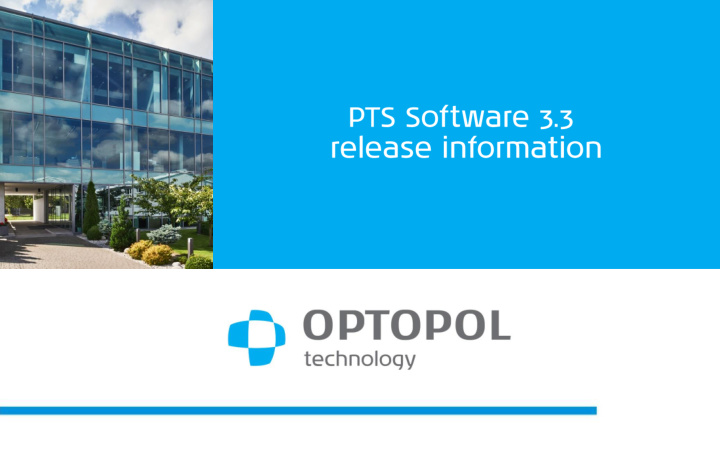



Contents PTS software release 3.3 highlights • EyeSee™ - eye recording • ZETA™ and ZETA™ Fast – new thresholding strategies • DPA™ - Defect Progression Analysis • Head Tracker – automatic head adjustment • Gaze Tracker 2.0 – improved test reliability • Other improvements • Reliablity tests frequency adjustment • Exams list in Perimetry Wizard • Quick Fast/Slow test speed switch • Dynamic Field Extension • Dynamic Retest • PTS software development road map •
EyeSee™ - eye recording EyeSee ™ - eye recording • Immediate preview of eye position at each • stimulus exposition Available during examination and in results • review page
EyeSee™ - eye recording EyeSee ™ - eye recording • Check eye fixation quality at uncertain test • locations Identify small pupils (pupil diameter changes • throughout the examination) Patient responses are marked in the EyeSee • images
EyeSee™ - eye recording EyeSee ™ - eye recording • Distinguish real defects from artifacts: • Ptosis •
EyeSee™ - eye recording EyeSee ™ - eye recording • Distinguish real defects from artifacts: • No correction lens • Not removed correction lens for peripheral • testing Lens holder shadow •
ZETA™ Standarad ZETA™ Standard • Zippy Estimation Thresholding Algorithm • 18 Uses Bayesian probability theory and probability • 16 density functions built from normative and 14 statistical data 12 10 More robust to patients accidental invalid • 8 Max responses - less defects in healthy visual fields 6 Min 4 High accuracy – at each location threshold is • 2 crossed at least once 0 Final threshold estimate is set at a probability • function’s peak - closer to real patient’s threshold 24-2 field takse 3,5-7 minutes Alternative to HFA’s SITA Standard • • 30-2 field takes 5-9 minutes • *Available on 10-2, 24-2, 30-2 test fields (PTS 925W, PTS 2000) *Available for stimulus with age normative data (White Goldmann size III, Green Goldmann size III)
ZETA™ Fas t ZETA™ Fast • Fast version of ZETA algorithm • 18 ZETA Fast requires at least one positive response • 16 to calculate the final threshold estimate - High 14 sensitivity to defects 12 10 Alternative to HFA’s SITA Fast • 8 Max 6 Min 4 2 0 24-2 field takse 2,5-5 minutes • 30-2 field takes 3-6 minutes • *Available on 10-2, 24-2, 30-2 test fields (PTS 925W, PTS 2000) *Available for stimulus with age normative data (White Goldmann size III, Green Goldmann size III)
DPA ™ DPA™ Defect Progression Analysis • Analysis of visual field defects in a long term • scale Separation of short term fluctuations from • real VF defects Extended progression analysis - comparison • of several examinations to a baseline Comparison of up to 16 results at once •
DPA ™ DPA™ Defect Progression Analysis • Each test point is assigned the Defect • Progression result according to its Pattern Deviation difference from the baseline and to history of Defect Progression result at this location Possible results of comparison to a baseline • point: Normal (no deterioration) • Deterioration in this test • Deterioration in 2 consecutive tests • Deterioration in 3 and more consecutive tests • Out of range (baseline is already deteriorated) •
DPA ™ DPA™ Defect Progression Analysis • Each compared test has assigned the DPA result: • No progression • Possible Progression (3+ points with significant deterioration in 2+ consecutive tests) • Likely Progression (3+ points with significant deterioration in 3+ consecutive tests) •
DPA ™ DPA™ Defect Progression Analysis • Analysis Results can be: • printed on multi-page • report exported to PDF • JPG • DCM • uploaded to DICOM • data storage
Head Tracker Head Tracker - Automatic head • position adjustment throughout the test monitors a pupil position during the test • adjusts chinrest height to align a pupil • Adjusts chinrest Left-Right position (PTS 2000 • only) to align a pupil Adjustments are done between expositions •
Gaze Tracker 2.0 Gaze Tracker 2.0 – improved test reliability • Gaze Gaze Tracker Tracker 2.0 Record pupil movement Stop when there is no eye in the preview Record fixation losses Hold the test when eye is closed/blink Hold the test when there is no fixation state Repeat the test when blink occured and there was no reaction (potential miss due to blink) Repeat the test when the fixation whas lost during exposition (potential invalid response do to no-fixation)
Other improvements Reliablity tests frequency adjustment • Frequency of FPOS, FNEG and HK test can be • adjusted to 5%, 10%, 15%, 20% Higher frequency of reliability test recommended for • rapid strategies like TOP, TOP+, Advanced, ZETA Fast
Other improvements Exams list in Perimetry Wizard • List of all examinations stored for a patient • Touch friendly - swipe to scroll the list • Direct access to Test Summary, Results Review • and Report Generator
Other improvements Quick Fast/Slow test speed switch • Double the reaction and pause time for • elderly patients with a single touch Use adaptive option to adjust the test speed • according to patient’s ability
Other improvements Dynamic Field Extension • Possibility to extend the test field with • additional peripheral points during the test Extend the test field to better visualize the • defects
Other improvements Dynamic Retest • Select points for which the test should be • repeated without waiting for the test end Instantly confirm defects in dubious test • locations
Recommend
More recommend